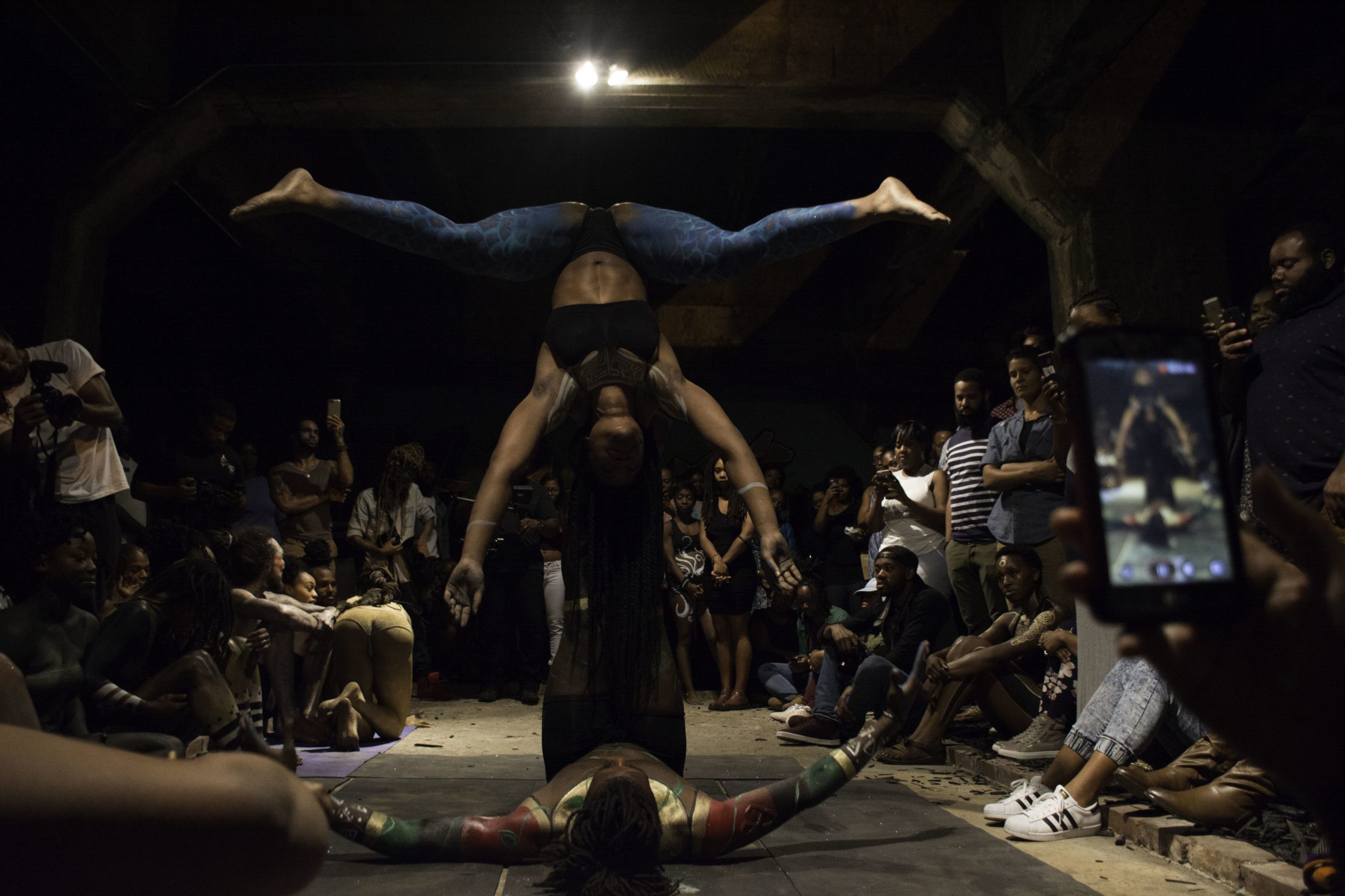
“Life is art.”
Uttered by Founder and Creative Director Allen “Rome” Batty, those three words are what inspired a movement. A movement that is based on the intersection of art, hip-hop and physicality; the epiphany that the fluidity of the human body is art itself.
Thus, the Moving Art Experience was born.
The interactive art exhibit only had its first show in June of 2015, but it has quickly become a fixture in the urban art scene for several cities. Their humble beginnings may have been in Atlanta, but they’ve now spread to Miami and New York City, and have plans to even go international one day, according to Director of Operations Rah Callender.
Rah Callender, who doubles as the Director of Operations and DJ, gave The Signal her take on the Moving Art Experience, her role in the movement and the role the movement plays in larger society.
Meet the founder
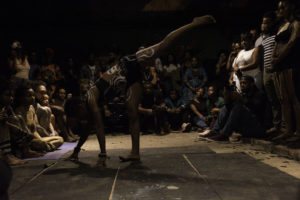
Photo by Jade Johnson | The Signal
Allen “Rome” Batty, who goes by Rome Allen, was not always a yoga spiritualist.=
The art dealer was going through a period of “soul searching” when he discovered the ancient practice, and it quickly became more than just a hobby to him. It became a lifestyle. Allen often refers to yoga as the experience that spiritually grounded him; where he found peace and balance in the chaos of life. After attending a particularly touching art show, Allen knew he had found the outlet for his new found passion: an urban art experience that would combine yoga, art and music.
“It’s beautiful [to see my vision become something],” Batty said. “To see it come to happen, to see it manifest…I’m blessed. [Moving Art] started [in Atlanta]. It’s always going to feel like this is where it’s supposed to be. Always. It’s for the people.”
Q&A: Rah Callendar
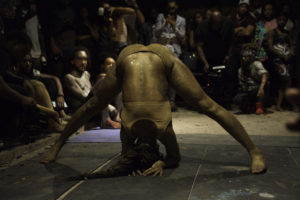
Can you describe your role in the Art Movement? Why did you get involved?
“I found out about Moving Art a year ago at their first show. I’m a DJ, so I wanted to support the art, and I just fell in love with everything. So I reached out to Rome Allen and asked if he needed a DJ. And after that, I became the official DJ. I also have a background in digital marketing and branding, and once he discovered my talent I came on as the Director of Operations. So I handle marketing, logistics, vending and I still DJ for the event. Marketing and branding is my day job, but DJing is still my passion.”
Moving Art is based on the intersection of art, yoga and hip-hop. As the DJ, what kind of role do you think music plays in the Moving Art experience?
“Actually, the main reason why I said that I needed to be the DJ was because that was missing at the first show. Moving Art is a platform to bring people together and to show different ways to heal- through yoga, art and different avenues to become a better person. Music is important in healing as well. As a DJ, I make sure that the music I play fits the vibe and atmosphere. I play anything and everything. There’s no genre that doesn’t get hit; soca, afrobeats, reggaeton.”
In that same vein, what do you think that Moving Art is trying to communicate between the intersection of these three art forms? How do they fit together?
“The whole show is not a performance-based show as opposed to other shows. People will see somebody [a performer] get into a yoga pose or painting a piece, and say ‘that could never be me,’ but we want to have a family feel. So when you come to the show, we’re all on the same level: we want our crowd to be just as involved as the artists. So if you want to paint or do a pose, go ahead. It’s definitely interactive; basically, we want you to say ‘I can do that.’ We want you to know that you can pick up a piece of paper and create your own art.”
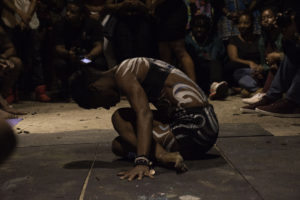
So what does the Moving Art movement mean to you? And in turn, what does the movement want people to walk away with after a show?
“For me, the movement was right on time. I had gone through a really bad situation in 2015, and I walked into that space, and there were people just like me. They might not to go through the traditional route of a job; they might be a yoga teacher or artist. That really solidified my purpose that the arts is the area I want to thrive in, and it showed me that there’s a community out there that is willing and accepting of me. By traveling to NY, Miami and LA, and even internationally, we could see that there are people who are very excited to see that there’s something going on that’s so needed in the minority community, especially today. I know that the art movement show in Miami happened around the same time as Philando Castile’s shooting. There was lots of unrest, protests; there was even a riot happening at the exact same time as the show. And that show was so emotionally charged, but in a positive way. It was so therapeutic; it felt like an oasis.”
You mentioned that the minority community needs this, what do you think seeing this kind of representation means to and for the minority community?
“It is a stereotype that when you think of yoga, you don’t see brown faces or the brown community. They think ‘that’s not for me’; even the artist community is not seen as a lucrative career, but there are so many avenues and ways to be successful. It doesn’t mean you can’t do it, just because of the color of your skin; we wanted to show through the [movement] that you can do it.”
What do you think the Moving Art Experience brings to Atlanta as a city?
“When the organization was first started, it was called Moving Art Atlanta because Allen was born and raised here, it’s his turf. Atlanta is known for a lot of things, but Atlanta is not known for this; so he really wanted Atlanta to be the home base. But then we realized that there were so many other communities that needed the same thing, so we decided to create the hashtag #movingart. As we were evolving, we knew that it could be more than just the minority community, more than just Atlanta. When you walk in a show all five of your senses are attacked: sight, sound, and taste, it’s all there. You gain an entire experience, and you walk away with so much more than just looking at art. So I sat down with Allen and said let’s change the name to the Moving Art Experience because this could be global. As soon as we did, started getting sponsorships from Europe and the Caribbean. But this is going to be our home, we have two shows a year here.”
A Night of Orishas: Description of the latest show
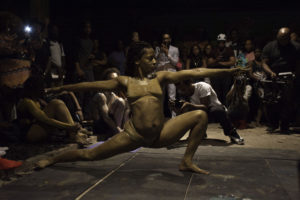
- The essence: In the middle of the show, the MC had stopped everything to encourage a moment of reflection and spiritual grounding. For that five-minute interlude, everyone was forced to be in the moment- to be grounded in the here and now.
“Inhale peace, exhale fear. Inhale love, exhale hate,” the MC instructed as she led the crowd in a meditation. “I am because you are, you are because I am.”
- The art: Various “yogis” (yoga performers) took the stage to showcase their body art and superhuman contortion abilities. The night was based around the theme of Nigerian minor gods (orishas), and the gold-streaked bodies of the performers was a nod to Yoruba tribal body paint. But the show didn’t stop there; artwork was displayed in every way imaginable, portraits of Tupac and Prince set haphazardly against exposed pipes and abandoned machinery.
